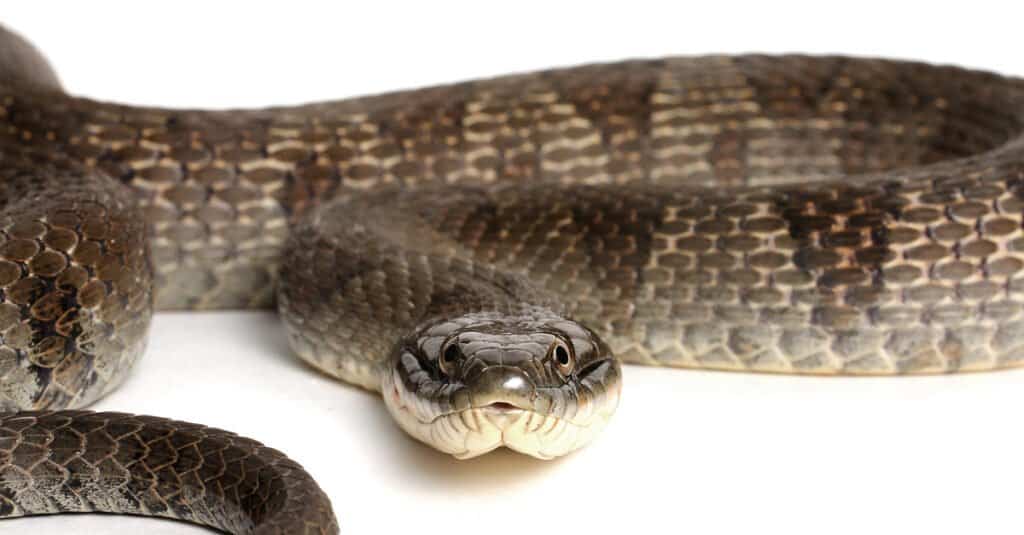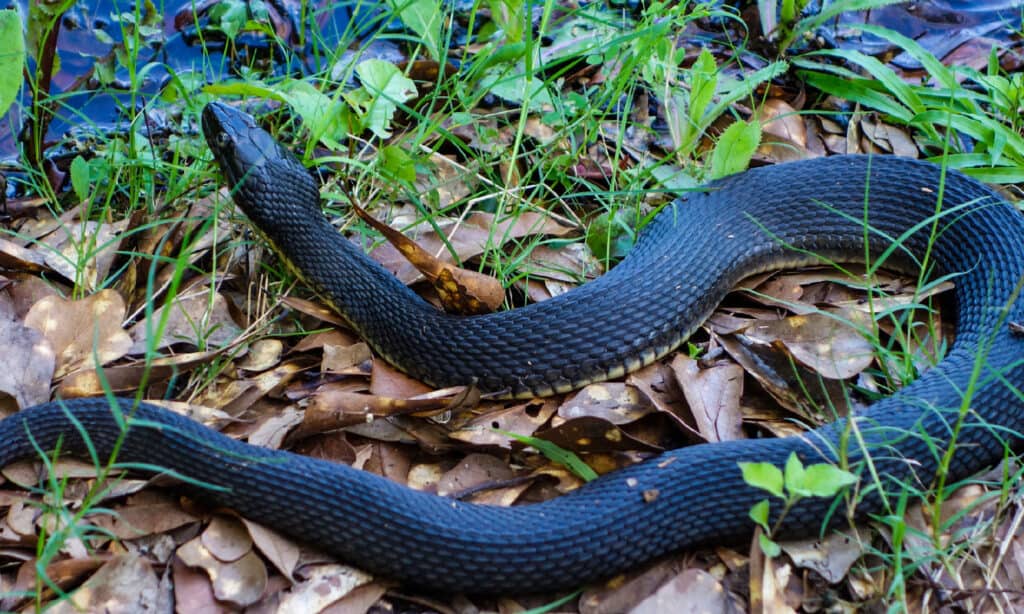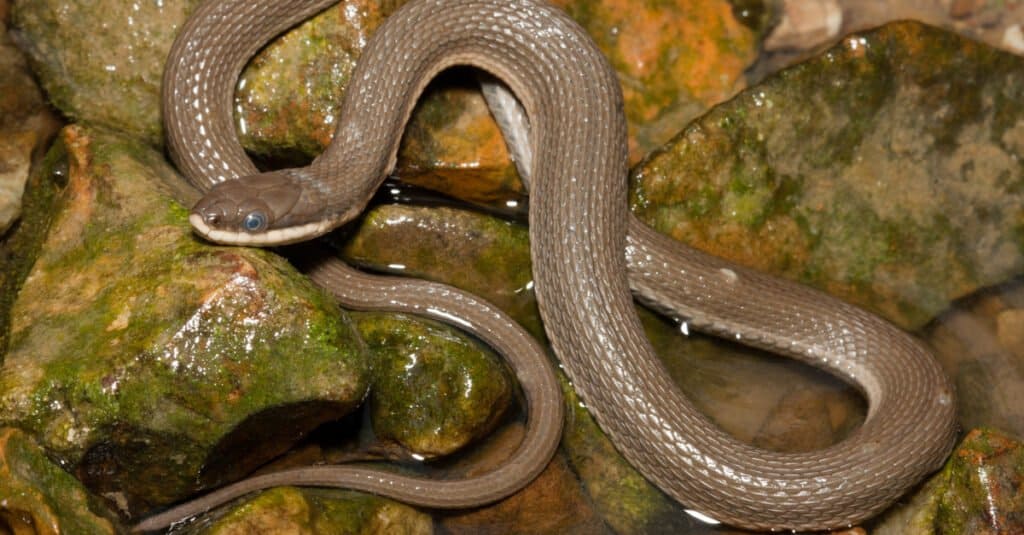The state of Delaware is popular for its lovely beaches and lack of state sales tax. It is also popular for its 19 snake species and, of course, the famous Delaware River. The Delaware River is one of the United States’ estuarine rivers and spans 301 miles (484 km) and drains an area of 13,539 square miles (35,070 km2).
According to the New Jersey Department of Wildlife and Fish, the Delaware River is home to at least 186 fish species recorded since 1980. It is also home to three water snake species that inhabit various parts of the river. Here are 3 snakes found in the Delaware River.
Northern Water Snake (Nerodia sipedon)

Northern water snakes are heavy and nonvenomous colubrids.
©Michiel de Wit/Shutterstock.com
The northern water snake is a medium-length but heavy aquatic snake that grows between 27.4 – 53.1 inches (2.2-4.4 feet) in length and weighs 2.9 to 20 ounces. These snakes are nonvenomous colubrids with dark crossbands and blotches atop their gray, brown, reddish-black skins. As they grow, these blotches and crossbands may become less visible.
They also have triangular heads and yellow, gray, or white bellies with black or red crescents. Because of this dark coloring, these snakes are often mistaken for venomous cottonmouths and wrongfully killed. Northern water snakes are some of the Delaware River’s most commonly spotted water snakes.
They can often be found on large rocks or debris near rivers but do not hesitate to jump into the water to escape when humans come too close. Northern water snakes are known by many names, including common water snakes and common northern water snakes.
Plainbelly Water Snake (Nerodia erythrogaster)

Adult plainbelly water snakes measure anywhere from 24 to 40 inches.
©iStock.com/Alex Pankratov
Plainbelly water snakes are nonvenomous and aquatic colubrid snakes that fall into the same water genus (Nerodia) as the northern water snake. However, unlike other water snakes with spotted or streaked bellies, the plainbelly water snake’s is plain yellow or red. Its scientific name “erythrogaster” is coined from the Greek words “erythros” and “gaster” which mean “red” and “belly” respectively.
Adult plainbellies measure anywhere from 24 to 40 inches (2–3.3 feet) in length and are colored black, olive green, brown, gray, and greenish-gray. Some specimens with lighter colors may even have dark dorsal blotches.
Plainbelly water snakes are known to travel farther away from water than any other snake species, especially in hot and humid weather. During these periods, they are active during the day and night. They also spend more time on land than other water snakes and are known to brumate during the winter.
Queen Snake (Regina septemvittata)

Queen snakes are only found in water that measures at least 50 degrees Fahrenheit.
©Nathan A Shepard/Shutterstock.com
The queen snake is one of Delaware’s hard-to-spot snakes for several reasons. For one, they are quite picky about where they live and are only found in the parts of the Delaware River with constantly clean running streams that measure at least 50 degrees Fahrenheit (10 °C) and have stony and rocky bottoms.
Queen snakes can be identified by their olive, gray, or brown colors patterned with seven stripes, which make up part of their scientific name (septemvittata means 7 stripes in Latin). One major way to identify adult queen snakes is to look out for 4 large and visible ventral stripes which are darker colored and run down their bellies.
The other three stripes are more visible in juvenile queen snakes. Considering its features and unique habitat requirements, the queen snake’s name perfectly suits its species.
What Do Delaware Water Snakes Eat?
Water snakes have varied diets depending on their species and where they live. The queen snake, for example, lives in specific habitats inhabited by crayfishes. However, unlike many other snakes in its family that feed almost entirely on adult crayfish, the queen snake feeds primarily on freshly molted juvenile crayfish. Juvenile crayfish do not have hard exoskeletons, which makes them easier to hunt and eat.
However, most other water snakes, such as northern and plain-belly water snakes, feed primarily on fishes, frogs, and tadpoles. Crayfish, insects, and salamanders are also common meals for water snakes. They also eat rats, mice, and shrews, but these occurrences are infrequent.
How Do Delaware Water Snakes Hunt Their Prey?
Water snakes are popular for their unique method of hunting. Since most aren’t venomous or constrictors, they rely on their unique body features and traits to locate and mark prey, and when they do, they gobble them up without chewing or biting.
While some water snakes mark their prey and swoop in to swallow them, others wait around their prey’s habitats. They stay hidden and with their mouths open, waiting for their prey to swim right in, and at the right moment, they snap their jaws around them and eat them. Queen snakes are known to stick their tongues out in the water to enable them to detect their prey through their Jacobson organ.
Do Delaware Water Snakes Bite?
Although Delaware water snakes do not have venom-transmitting fangs, they have multiple sharp rows of teeth. Most water snakes flee at first sight of a human, but if the snake is cornered and cannot escape, it will attempt to defend itself. Some snakes, such as the queen snake and the northern water snake, emit a foul-smelling musk from their cloacas when picked up.
Their musk is often mixed with feces and has an odor that is notoriously hard to get rid of. If this doesn’t work or if a snake doesn’t have musk, it can and will bite. Since water snakes are mostly reclusive, it is often wrongly assumed that they do not bite. Water snakes bite but only do so when they are cornered or handled.
Are There Venomous Snakes in the Delaware River?
There are no venomous snakes in the Delaware River. In fact, the state is known to have only one venomous snake, which is the copperhead. Copperheads are venomous pit vipers known to bite more people than any other snake in America. However, copperheads don’t have extremely potent venom. About 0.01% of people die from copperhead bites, and these fatality cases happen because the victims do not get medical care fast enough.
Are There Water Moccasins in the Delaware River?
Water moccasins, also called cottonmouths, are venomous semi-aquatic snakes. They bite less frequently than the copperhead but have a more dangerous and toxic venom that can cause immense pain and swelling in addition to transmitting venom. There are no water moccasins or cottonmouths in the Delaware River.
The photo featured at the top of this post is © Paul Brady Photography/Shutterstock.com
Discover the "Monster" Snake 5X Bigger than an Anaconda
Every day A-Z Animals sends out some of the most incredible facts in the world from our free newsletter. Want to discover the 10 most beautiful snakes in the world, a "snake island" where you're never more than 3 feet from danger, or a "monster" snake 5X larger than an anaconda? Then sign up right now and you'll start receiving our daily newsletter absolutely free.
Thank you for reading! Have some feedback for us? Contact the AZ Animals editorial team.






